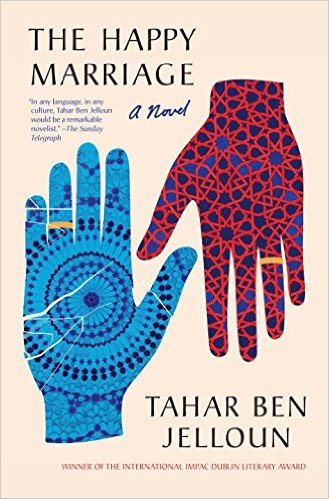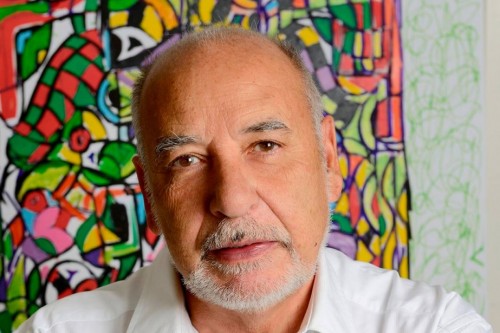Although Ben Jellouns writing is simple and straightforward, he does take chances in structure and effect. The narrative shape of The Happy Marriage is corrugated and layered—like the broken and fretful marriage it depicts. It is problematized by withheld information and the character’s anguish and paranoia. —Jason DeYoung

The Happy Marriage
Tahar Ben Jelloun
Melville House, 2016
$25.95
.
“If we knew what went on between women and men,” Mavis Gallant once said, “we wouldn’t need literature.” This quotation played over in my mind as I read The Happy Marriage, a novel that at times I thought uninspired and clichéd (albeit self-aware of it), and yet at other moments heartbreaking and authentic. The Happy Marriage is about that most ancient and indefatigable topic: betrayal. Only in The Happy Marriage we glimpse it through the eyes of a man and woman during social changes in Moroccan laws and customs, when men no longer hold all the power to determine when a marriage has ended, and when women are enacting more control over their own lives.
Born in Morocco in 1944, Tahar Ben Jelloun was the first North African writer to win the Prix Goncourt Prize for his novel The Sacred Night (1987) and has been short listed for the Nobel Prize for Literature. The author of over fifteen novels, he’s is best known for a trilogy about the life of Ahmde/Zahra, a girl who is raised in Morocco as a boy. More recently, he won The International Impac Dublin Literary Award for his novel This Blinding Absence of Light (2000), a novel that depicts the real-life, twenty-three-year prison sentence of a survivor of King Hassan II’s desert concentration camp, where political enemies were kept in lightless, underground cells with little food or water. Most of his novels, however, are more like The Happy Marriage, preoccupied by the daily life and relationships between men and women in Muslim society. They often focus on escaping its dogmas (Leaving Tangiers) or returning to its comforts (The Palace in the Old Village).
Ben Jelloun lists the typical Western pantheon of influences—Joyce, Cervantes, Pessoa. But he is on record of saying that he doesn’t really identify with other writers, “rather with certain filmmakers: Orson Wells, Federico Fellini, Yasujiro Ozu, Akira Kurosawa, Michelangelo Antonioni.” These cinematic influences inform nearly all of is fiction, generally through one of his characters being a movie aficionado. He does, however, state in interviews that Jean Genet, who he knew in the 1970s, gave him one piece of important advice, which Ben Jelloun has followed: “When you are writing, think of the reader, be simple,” Genet advised.
Although Ben Jellouns writing is simple and straightforward, he does take chances in structure and effect. The narrative shape of The Happy Marriage is corrugated and layered—like the broken and fretful marriage it depicts. It is problematized by withheld information and the character’s anguish and paranoia. It is novel in two parts—one male, the other female. Part One is entitled “The Man Who Loved Women Too Much” and Part Two is “My Version of Events: A response to The Man Who Loved Women Too Much.” It’s a tit-for-tat kind of book, similar to another of Ben Jelloun’s novels, The Last Friend (2006).
Part One is the man’s side of things. Known only as the painter, his narrative opens in Casablanca, February 4, 2000. He is bedridden after a stroke, and he is unable to paint. At one time he was a celebrated artist, but now he lives out his days being cared for by a pair of twins who helps him get a round, and is visited by Imane, a physiotherapist, who is helping him regain muscle control. It is a portrait of an invalid that Ben Jelloun presents, but the painter’s mind is still alive, vivid, and over the course of the first part of the novel, he reflect back over his life, dwelling mostly on his unhappy marriage.
At first the marriage is indeed a happy one. The painter and his bride are very much in love. They are, however, from two different strata of Moroccan society (he from something higher than she), and there is also fourteen-year difference in their ages (he is 38; she is 24). “Nobody present [at their wedding] had been happy, apart from the painter and his wife,” we are told. “Nobody had wanted them to get married. One had to be absolutely crazy to want to bring such different worlds together.”
It’s difficult for the painter to trace the beginnings of their marital troubles, saying, “once their son was born, his wife gained a great deal of confidence and her attitude and behavior underwent a vast transformation.” Slowly the small moments of martial discord become a stridency of outrages and indignities. The wife is portrayed as irascible, irrational, and prone to fits. The painter freely confesses to a multitude of affairs, some as short as one night, others that went on for years, followed with heartbreak. Yet, he never sees himself completely in the wrong: “At no point did the painter feel guilty,” we’re told. “He was doing nothing wrong, he was simply looking for some equilibrium outside of his marriage, which only functioned intermittently.”
What’s not revealed until late in the novel is that the painter’s section is being written by an amateur writer, who visits the painter regularly during his convalesce. The two friends chat, the writer types and polishes (reshapes, I often wondered) the story the painter has told, and the pages are kept in the painter’s safe. It is this manuscript—in which the painter blames his wife for all his misery and illness—that the wife finds and prompts her to pen her response.
Part Two is a first-person narrative and a rejoinder to the painter’s side of the story. Unlike the painter who never reveals his own identity, the wife proudly states her name—Amina Wakrine. In comparison to the painter, Amina doesn’t seem to shy from her flaws. Her first words sum up how she sees herself: “Before giving you my version of events, I must warn you that I am nasty.” The wife has a cold eye for herself and for others. What we learn from her more clinical approach to the story of their marriage is that the painter, whom she calls Foulane, an Arabic word used to refer to “any old guy,” is that their marriage had more complexity that he revealed. Yes, there were the infidelities, but also he withheld money from her, despite earning more than enough from his paintings. But his family—not the one he created with Amina, but his siblings—was always his first concern, and he made his wife and children live off a small allowance.
For a while we take the wife’s side of the story as truer—both her petty and principal complaints seem more sincere than the husband’s—until she begins to edge into paranoia, and rants about all the evil spells she believes the painter’s family have cast on her:
Foulane said he didn’t believe in such things, but I had proof that the women in his family were using sorcery against me… I cleaned the house from top to bottom. My friends helped me and we found little packets wrapped in tin foil all over the house, tucked under each bed and inside the toilets. The house was overrun by spells designed to make me ill.
And just like in the painter’s half, we begin to doubt her integrity. Suspicious spreads like an epidemic in this work.
The end of the novel leaves us with our own decision to make (if we care to, that is). Who’s right? Who’s wrong? In both parts, we have common statements of awareness:
While he’d never necessarily wanted his wife to one day grow docile and submissive, he had always harbored a secret hope that she would at least become loving and obliging, calm and reasonable, in short, a wife who could help him build a family life and then share it with him. It had been his dream. But he’d been misguided and he had instead oppressed his wife, forgetting to acknowledge his share of responsibility for that failure. (The Painter)
My mistake was to think people can change. None of us change, not least of which a man who’s already lived out most of his life… (The Wife)
Clearly, both narrators are flawed, and Ben Jelloun does a fine job of not betraying loyalty or agreement with one character over the other—unless you equate giving the wife the last word as consensus. In a Paris Review interview with Ben Jelloun, he says that his “job is not to give answers or to find solutions, but to ask questions, to testify in a human situation….[to] tell a story in hopes that it will incite reflection, provoke thought.” If provoking thought is his goal, I feel he’s done so. As I sit here parsing out this book, I keep coming back to the fact that I just don’t like these characters, neither one. The painter is an ass; the wife is mentally cracked. But then, why do I think these things? Why do I judge them so harshly?
The novel is keenly aware of the changing tensions between men and women in Moroccan society. Often the painter’s section reeks of chauvinism, while the wife’s section smartly leans in a more feminist direction. The infidelities and betrayals, which are damaging yet described quite rightly as “banal,” are in some ways pretense to show the changing political values. Whereas a lesser novelist might have chosen younger characters to portray this change, Ben Jelloun chooses middle-age characters, those whom perhaps would feel the change more intensely. Amina acknowledges “in our culture, a woman who cheats on her husband no longer has any rights, everyone thinks badly of her, even if she was victimized by a lying, violent husband.” Thusly, she enacts her revenge through the changed marriage laws, refusing to divorce the painter, stating:
I’ll never leave Foulane, I’ll never leave him alone. He has to assume his responsibilities. I couldn’t care less about his health, mood or state of mind. I’ll never stop hating him so long as my thirst for revenge isn’t quenched. One day I’ll rebuild my life, but not before he’s paid the price. So long as he refuses to atone for what he’d done to me, or publicly confess in front of everyone, I’ll revue to let go! I’m too proud to leave him. I’m full of hate, and if anyone were to shake me, drops of poison would inevitably fall out.
If this is a happy marriage, it’s not a sense of happiness that many will identity as such. Despite their early nuptial contentment, these are two miserable people, made so by life, ego, family, and conflicting desires and ambitions. One of the tropes that Ben Jelloun uses in the novel is montage: the painter dives deep in his memory, pulling images of the women he loved up and remembering their time together. The Happy Marriage in many ways is part of montage of unhappy marriages that I’ve seen, and perhaps you’ve seen, too. I can’t say this is a good place to start reading Ben Jelloun in English—I’d give that to The Last Friend or Leaving Tangiers. But what The Happy Marriage does do well is give us a solid portrait of two flawed individuals, and their example, one can only hope, might help to make the next marriage a happier one.
—Jason DeYoung
Jason DeYoung lives in Atlanta, Georgia. His work has appeared or is forthcoming in numerous publications, including Booth, Corium, The Austin Review (web), The Los Angeles Review, New Orleans Review, Monkeybicycle, Music & Literature (web), 3:AM, and Houghton Mifflin Harcourt’s Best American Mystery Stories 2012. He is a Senior Editor at Numéro Cinq Magazine.
.
.

